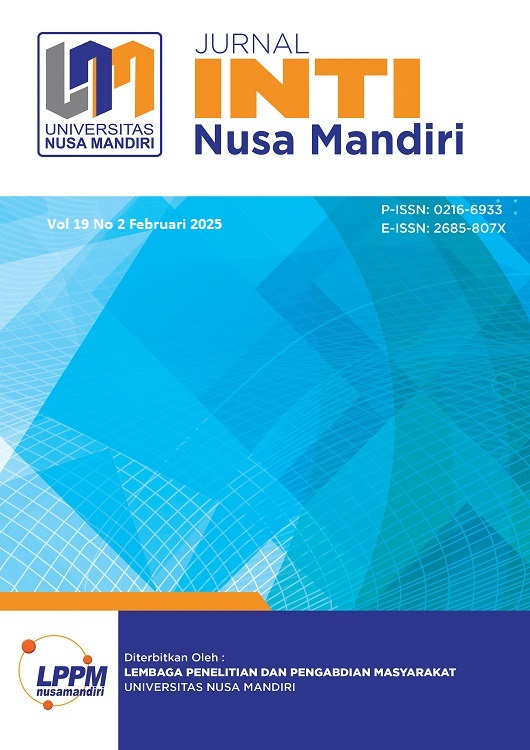EVALUASI PENERIMAAN PENGGUNA APLIKASI ADONAI DENGAN PENDEKATAN TECHNOLOGY ACCEPTANCE MODEL (TAM)
DOI:
https://doi.org/10.33480/inti.v19i2.6077Keywords:
adonai application, perceived ease of use, perceived usefulness, technology acceptance, Technology Acceptance ModelAbstract
The Adonai application is designed to make it easier to submit insurance and claims for customers by Kosppi employees, but the level of acceptance still needs to be researched. This research uses the Technology Acceptance Model (TAM) to evaluate the influence of perceived usefulness (9.92%) and perceived ease of use (35.04) on application acceptance. Analysis of data from 53 respondents shows that the two variables simultaneously contribute 66.8% to application acceptance. The results of this research support the validation of TAM as a technology evaluation model in the financial services sector and provide practical recommendations to increase the ease of use and benefits of the adonai application.
Downloads
References
Alfarizi, M., & Zalika, Z. (2023). Isu Persaingan Industri Pelayanan Kesehatan Indonesia: Tantangan dan “Perisai” Pengawasan KPPU. Jurnal Persaingan Usaha, 3(1). https://doi.org/10.55869/kppu.v3i1.89
Amalia*, J., Fitrianingsih, I., & Pandapotan Nainggolan, S. (2023). Pelatihan Metode Ilmiah dan Analisis Statistika untuk Siswa SMKS Arjuna. Dinamisia : Jurnal Pengabdian Kepada Masyarakat, 7(5). https://doi.org/10.31849/dinamisia.v7i5.15818
Juni, E. V, Wowor, H. F., & Paturusi, S. D. E. (2021). Analisis Tingkat Pengalaman Pengguna terhadap Aplikasi Online Shopping di Area Urban Fringe. Jurnal Teknik Informatika, 15(3), 209–216.
Matondang, Z., & Nasution, H. F. (2022). Praktik Analisis Data: Pengolahan Ekonometrika dengan Eviews dan SPSS. Merdeka Kreasi Group.
Mukhlis, Z. U. (2021). Koperasi dalam Perpektif Hukum Islam. Jurnal Kawakib, 2(2), 90–99.
Mutiara, T. A., & Cahya, F. N. (2022). Penerimaan Teknologi Dalam Pendidikan Studi Kasus: Calon Guru Di Indonesia. Jurnal Responsif: Riset Sains Dan Informatika, 4(2), 222–230.
Pratama, H. S. P., & Rakhmadani, D. P. (2022). Penerapan Metode Technology Acceptance Model (TAM) Dalam Penggunaan Aplikasi Linkaja. JURIKOM (Jurnal Riset Komputer), 9(2), 176.
Putri, L. M., Kurniawan, A., Mamesah, M. M., & Trisnawuri, S. (2023). Perspektif Pasien Hipertensi Terhadap Implementasi Personal Health Record Berdasarkan Technology Acceptance Model. Jurnal Manajemen Kesehatan Yayasan Rs. Dr. Soetomo, 9(2), 332–346.
Sriyati, S. (2022). Analisis Hasil Tes Potensi Skolastik sebagai Indikator Kesiapan Siswa Menghadapi Tes UTBK 2022. Tarbiyah Wa Ta’lim: Jurnal Penelitian Pendidikan Dan Pembelajaran, 74–83.
SUGIHART, L., Farihah, E., SE, M., HARTADINATA, O. S., SE, M. A., AJIJA, S. R., & SE, M. E. (2021). Statistik multivariat untuk ekonomi dan bisnis: menggunakan software SPSS. Airlangga University Press.
Susinta, A., & Senjaya, R. (2022). Manajemen Perpustakaan Digital Di Era Global Pada Perpustakaan Kampus Institut Pemerintahan Dalam Negeri. UNILIB: Jurnal Perpustakaan.
Toros, E., Asiksoy, G., & Sürücü, L. (2024). Refreshment students’ perceived usefulness and attitudes towards using technology: a moderated mediation model. Humanities and Social Sciences Communications, 11(1), 1–10.
Waciko, K. J. (2022). Statistik Bisnis (Aplikasi dengan SPSS).
Wijaya, H. (2018). Analisis Data Kualitatif Ilmu Pendidikan Teologi. Sekolah Tinggi Theologia Jaffray.
Zakariah, M. A., & Afriani, V. (2021). Analisis statistik dengan spss untuk penelitian kuantitatif. Yayasan Pondok Pesantren Al Mawaddah Warrahmah Kolaka.
Downloads
Published
How to Cite
Issue
Section
License
Copyright (c) 2025 Fani Nurona Cahya, Hikmatulloh Hikmatulloh, Rangga Pebrianto, Deny Novianti

This work is licensed under a Creative Commons Attribution-NonCommercial 4.0 International License.
Penulis yang menerbitkan jurnal ini menyetujui ketentuan berikut:
1. Penulis memegang hak cipta dan memberikan hak jurnal mengenai publikasi pertama dengan karya yang dilisensikan secara bersamaan di bawah Creative Commons Attribution 4.0 International License. yang memungkinkan orang lain untuk berbagi karya dengan pengakuan atas karya penulis dan publikasi awal pada jurnal.
2. Penulis dapat memasukkan pengaturan kontrak tambahan yang terpisah untuk distribusi non-eksklusif dari versi jurnal yang diterbitkan (misalnya, mengirimkannya ke repositori institusional atau menerbitkannya dalam sebuah buku), dengan pengakuan atas publikasi awalnya pada Jurnal.
3. Penulis diizinkan dan didorong untuk memposting karya mereka secara online (misalnya, dalam penyimpanan institusional atau di situs web mereka) sebelum dan selama proses pengiriman, karena hal itu dapat menghasilkan pertukaran yang produktif, serta kutipan dari karya yang diterbitkan sebelumnya.











